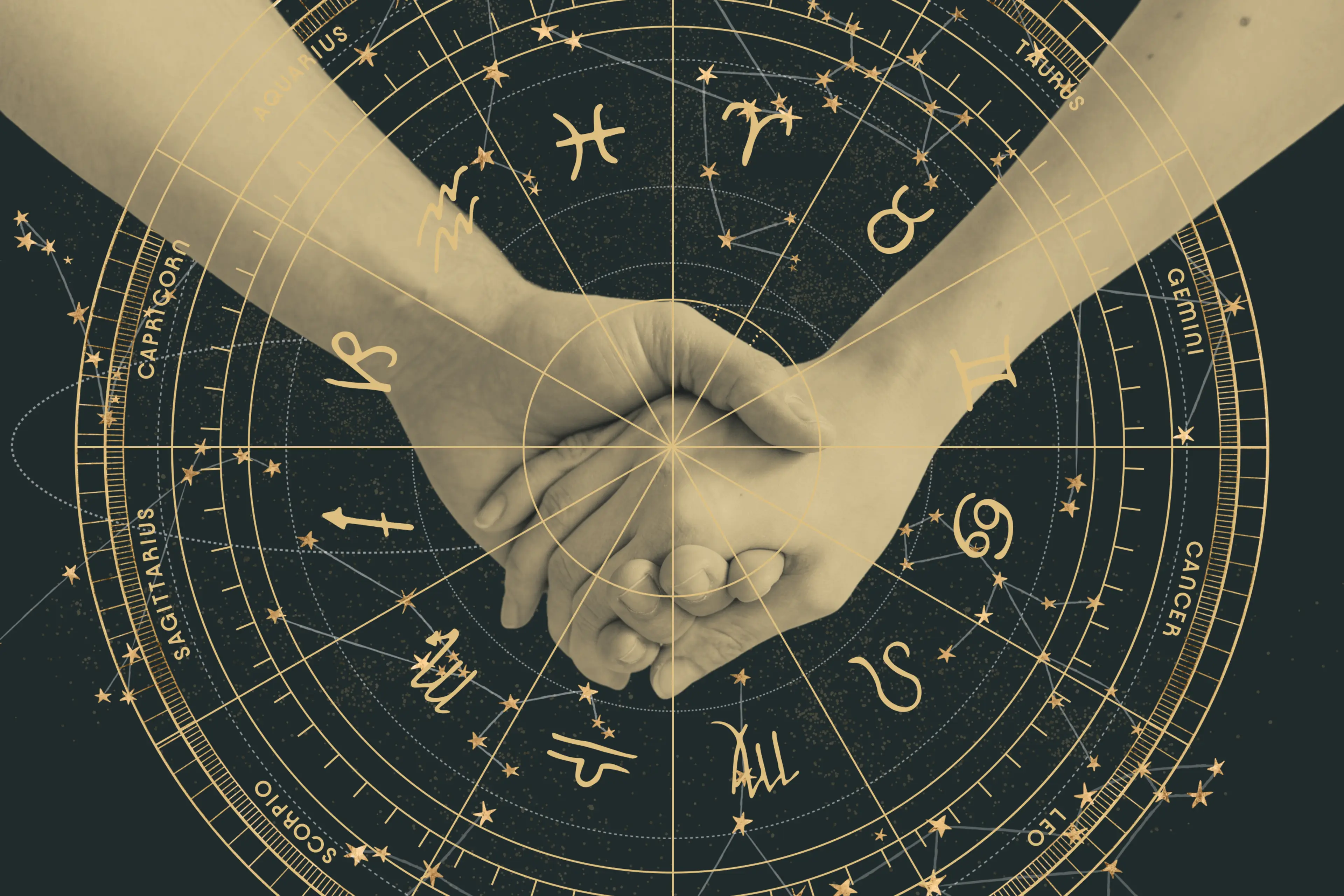The Greek roots of the word synastry roughly mean “together stars.” And indeed, synastry is the practice of bringing two astrological charts together to observe how planetary interactions influence a relationship.
What Is Synastry?
By layering one birth chart over another, you can compare the positions of the planets within the zodiac. This comparison reveals how each person perceives and affects the other, as well as defining relationship patterns across different areas of life.
Many sources classify interactions as relatively challenging or harmonious. However, it’s often more helpful to view each interaction as containing neutral information, full of the potential for either positive or negative impact on the relationship.
With awareness, for example, a superficially “difficult” influence could be an opportunity for growth. This is especially true if the individual natal charts suggest that both people appreciate a challenge!
How to Read Your Synastry Chart
In relationship astrology, a synastry chart is a composite of two birth charts. Typically, an inner ring contains one partner’s houses and the planets within them. An outer ring shows this information for the second partner.
Observe how one individual’s planets—which represent different personality traits—show up within their partner’s houses. Depending on the activities governed by a given house, the partner could experience the other planets as supportive or meddling.
Note that date of birth, time of birth, and place of birth will influence the position of the planets on your horoscope.
Aspects in Synastry
Just as you calculate angles between planets in a birth chart, you can do so between partners’ planets in a synastry chart interpretation. Some astrologers call synastry angles “interaspects” to distinguish them from each individual’s aspects.
In synastry, aspects give insight into how partners interact, including points of tension, compatibility, and appreciation. Note that the participating planets, houses, and zodiac signs further characterize each aspect of a relationship.
Conjunction: This angle is nearly zero, indicating that the planets are in the same location. If you feel deeply seen in a relationship because of a quality you both share, a conjunction is likely involved.
Sextile: This angle is wider, so the planets can appreciate their differences. Although sextiles don’t usually generate a spark like some other angles, they represent areas where partners learn that they complement each other beautifully.
Square: With squares, the energies are grating. As a result, square angles reveal where a couple repeatedly faces conflict. But just as friction is necessary to light a fire, squares can be thrilling—for better or worse.
Trine: This angle brings loving energy into the relationship. Warmth and understanding between trine planets generally create areas of utmost appreciation.
Opposition: Opposites do attract, and many oppositions can bring a balancing effect to a relationship. However, this angle can also create a push-pull that makes each partner feel unappreciated or defeated in some contexts.
Houses in Synastry
When you interpret a synastry chart, also known as a composite chart, you can also examine the three houses that traditionally rule relationship activities. Be sure to look at how planets appear in the following houses for both partners.
Eighth House: This house is the engine of intimacy, everything from sex to merging personal finances. It represents the transformation two people undergo through their relationship. For instance, your Moon appearing in a partner’s eighth house could mean that you inspire deep desire and care.
Seventh House: Traditionally called the “relationship” house, the seventh house influences how you form bonds and resolve conflict. If your partner’s Venus is in your seventh house, commitment can elevate your attraction, sustaining your devotion through tough times.
Fifth House: Though not as “deep” as the seventh and eighth, the fifth house fuels joyful romance. With your partner’s Jupiter in your fifth house, for example, you're drawn to the relationship because you laugh together often.
Note that astro planetary placements also point to the houses that matter most for each unique relationship. For instance, significant sixth-house placements indicate the importance of service, while ninth-house placements may mean that shared learning is a relationship theme.
Overall, house overlays tell you what the influences are, and aspects then provide more information about how these influences show up in the partnership.
Planets in Synastry
In general, the interplay of planets shows relationship roles. In combination with houses and aspects, planets reveal when you’re likely to express certain sides of yourself and how that expression affects your relationship.
Although experienced astrologers will provide more nuanced interpretations, aspects between the following personal planets are generally meaningful:
Moon: Both partners’ Moon placements (luminaries) reveal inner awareness and how emotions are activated. For instance, you may develop a sense of belonging through a relationship if your Moon is sextile your partner’s Jupiter.
Venus: As the planet of love, Venus shows where tenderness, attraction, and the desire to build a home are highest. Venus trine Mercury, for example, tends to make communication easy and loving.
Mars: Knowing your partner’s Mars placements helps you understand where they’re most assertive and strive to take action. When your partner’s Mars is trine your Moon, you help your Mars partner understand the emotional intent behind their actions.
Sun: Perhaps the most obvious, your Suns are spotlights on certain houses within the relationship, identifying what you bring out in each other. Your Sun sign in your partner’s eighth house amplifies their desire for mutual transformation.
Mercury: As the planet of communication, Mercury doesn’t often create sexual attraction, but its placement can support mutual understanding (or reflect frequent misunderstandings). Mercury square the Moon might mean that one person shuts down due to the other’s communication style.
In addition to personal planets, the relationship between the ascendant houses is a high-level indicator of compatibility or soulmates. Trine ascendants, such as Taurus and Virgo, understand one another’s motivations, leading to a feeling of compatible life goals.
Finally, the outer planets carry generational energy and karma. For this reason, many interaspects involving Jupiter and especially Saturn can reflect karmic lessons that you and your partner are working through together in this lifetime.

